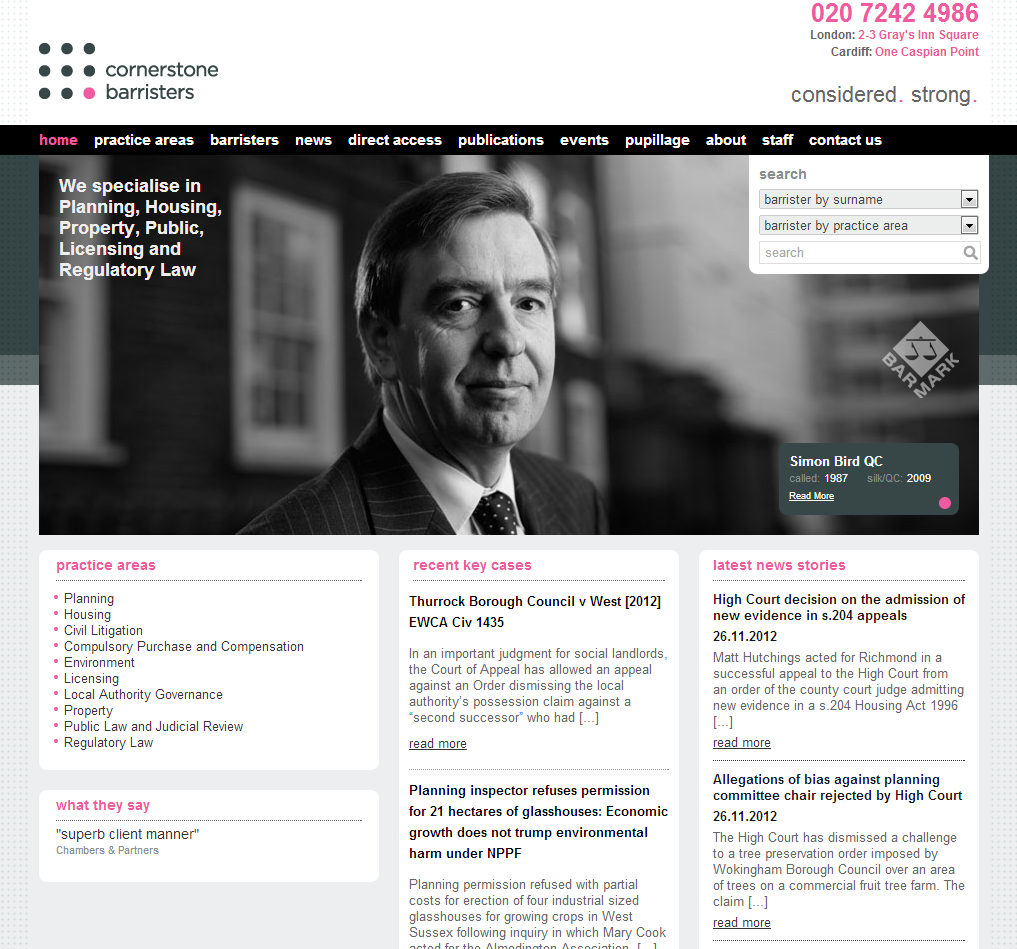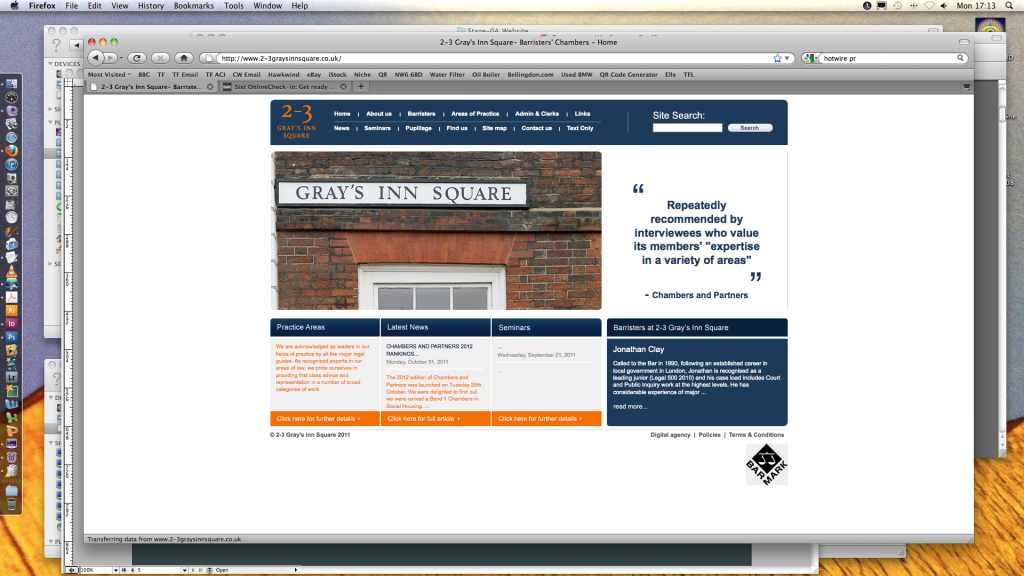Cornerstone Barristers case study
In October 2010 Cornerstone Barristers experienced something of a wake-up call. Chancellor George Osborne had just unveiled the UK’s biggest spending cuts for decades. As part of a whopping £81bn cuts package, the government said local authority funding would be reduced by 27%. Those same local authorities represented the bulk of Cornerstone’s client revenue, and it was a defining moment, as Bryan McGuire, a QC with the chambers, explains:
“We work with about 300 local authorities and that news meant their spending ability would soon fall by almost a third. There would inevitably be losers and it created what was our ‘burning platform’ moment; we had to act quickly and decisively to protect our leading position in what would soon become a much smaller market.”
McGuire is a member of a small management group overseeing how Cornerstone ope
rates. At the start of 2011 that group made two key decisions: to hire a chief executive, a newly created role to lead and manage the organisation on more commercial lines; to invest in some senior-level marketing expertise as a way of protecting its market share and modernising.
“We recognised it might take up to a year to find and hire the right chief executive but we had to start immediately with marketing because the cost of delay would be loss of market share. That’s why we began to look for an interim marketing director.”
Crispin White has been an interim marketing director for six years. His background includes roles in well-known management consultancies and more recently as part-time marketing director of BIE Group, an executive search firm and specialist provider of senior level interim executives. When BIE managing director Nick Diprose was asked to discuss Cornerstone’s needs, he met them with an open mind but soon recognised BIE Group’s own marketing director was the perfect fit. White takes up the story:
“I went in to see them and was panel-interviewed twice by five barristers; it was a memorable experience but it soon became apparent how I could help. There were many improvement opportunities that individually were relatively minor but collectively would have a huge impact.”
Although speed was critical, Bryan McGuire says he and colleagues took time to create a very detailed assignment brief for White, showing what they wanted to do and why but without being overly prescriptive.
“On reflection, that was crucially important. The delivery expectations were clear, as was the budget. We are an organisation with 55 decision makers so having this agreed early was vital,” he explains.
White’s six month assignment, in outline, was to:
- Review the existing marketing strategy, adjusting it to reflect the changed market circumstances and protect market share
- Conduct a ‘gap analysis’ of existing support resources and recommend how to fill any identified gaps
- Review all existing market and client communications, to better showcase expertise, build dialogue and deeper engagement with both clients and referring solicitors
- Overhaul the website to better represent the organisation and its areas of expertise, and make it content-driven to increase visits and the amount of time visitors spent on the site
Cornerstone’s McGuire says the results after six months have been impressive:
“It is fair to say that we were unaware of what we’d been missing until someone showed us. Marketing in the Chambers was not recognised as strategically important, more just a tactical activity. Crispin began by taking us back to the square one, asking some tough but quite fundamental questions. He initiated the process of getting us properly to define not just who we are and what we do, but also how we should sell our expertise in a much more professional way.”
This process involved interviewing most of the 55-strong decision makers in the Chambers to better understand perceptions, solicit ideas and scope out opportunities. Cornerstone at this time was still known only by its address – a long-standing tradition in the legal sector. One of the clear outcomes of White’s marketing audit was a collective desire to modernise and be forward-thinking. White already knew that the Chambers’ website could become much more valuable as a marketing resource and now it became clear that the introduction of a new, corporate-style brand could also be used to signal a clear and visually tangible break with the past.
By this point Cornerstone had found its new chief executive Warren Foot, but he was still working out his notice period as managing partner of a medium-sized law firm. Recognising the fundamental importance of Crispin White’s work to the organisation he would soon lead, Foot asked for a briefing.
“It was early December 2011 when I first met Crispin. I couldn’t join the Chambers until April 2012 but naturally I wanted to understand what was happening in detail; the rationale for the changes proposed and what plans were being made, says Foot.
“Crispin took me to meet the branding agency he had worked with on previous assignments and we went through the new brand strategy and thinking. It was my first exposure to someone doing what Crispin does and it was very impressive. I was amazed at what he’d been able to do – that he’d reached consensus with so many decision-makers, so quickly,” he adds.
The introduction of the new, corporate-style brand of ‘Cornerstone’ coincided with the launch of a new, content-driven website. These two visual changes, plus a big overhaul of the Chambers’ customer relationship management (CRM) system have helped to transform how the barristers communicate and engage with their audiences, says Cornerstone’s Bryan McGuire:
“The old website was really just a static digital brochure, whereas the new one is much more dynamic; it’s a powerful channel for demonstrating expertise, knowledge and communicating our events programme. We’re adding news and other valuable content every day. In turn, that’s driving up visitor numbers and engaging them for longer on the site, where they can discover other services of potential interest to them.
“Crispin’s experience, approach and contacts allowed us to do everything we wanted: we have a modern, differentiated new look that people are proud to be associated with; we have improved audience intelligence and targeting; and deeper, more frequent engagement with those groups. These changes have been extremely well-received outside Chambers too, and that has re-invigorated our culture.
“When I look back now to 2011 and where we started, what we needed was quite a tall order: good value, an immediate start, a fast operator who was also very capable in both strategy and execution.” concludes McGuire.
There are already signs of a hard financial return on Cornerstone Barristers’ marketing investment. While the effects of those original local authority budget cuts that first spurred them into action have still not fully played out, revenue at Cornerstone is up 11%, year on year.
Cornerstone BIE 2013 case study
The old site and branding:
 Chiswick Marketing
Chiswick Marketing 
